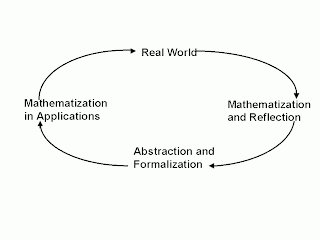Reflection
Paper
Understanding
RME
Researcher
: Prof. Zulkardi
1.
Philosophy and characteristics of RME
The combination of Van Hiele’s three levels,
Freudenthal’s didactical phenomenology and Treffer’s progressive
mathematization (Treffers, 1991) result in the five characteristics (tenets) of
RME (de Lange, 1987; Gravemeijer, 1994) :
a.
The use of contexts in phenomenological
exploration
The
process of extrating the appropriate mathematical concepts from concrete
situation ii called conceptual mathematization. And the process of apply
mathematical concepts to other aspects of their daily life, and by so doing,
reinforce and strengthen the concepts is called applied mathematization. This figure show the conceptual and applied
mathematization by de Lange, 1987.
b.
The use of models or bridging by vertical
instruments
The
model of concepts is important to the pupils to developed their knowledge. The
model of a situation must be familiar to the pupils. By a process of
generalizing and formalizing, the model eventually becomes entity on its own.
It then becomes possible to use this entity as model for mathematical
reasoning. This figure show th levels of models in RME by Gravemeijer, 1994.
c.
The use of pupils’ own creation and contributions
The
free production by pupils showed that pupils force themselve to understanding
the learning process, and can form an essential part of assessment.
d.
The interactive character of the teaching process
or interactivity
Interaction
between pupils and teachers is an essential part in RME instructional process,
explicit negotiation,
intervention, discussion, cooperation and evaluation.
e.
The intertwining of various mathematics strands or
units
The
Intertwining of learning strands is exploited in solving real life problems.
2.
Designing RME curriculum materials
The characteristics of RME are pictures in a
model for designing RME curriculum materials. This figure adapted from
Streefland, 1991.
3.
RME exemplary lesson materials
RME exemplary lesson materials refer to
learner materials and teacher guides. It consist of the following main
components : content materials, learner and teacher activities and assessment.
4.
To sum up, RME have five characteristics,
curriculum materials, and assessment. It have purpose to make students
understand about mathematics and enjoy to study mathematics.



















0 komentar:
Posting Komentar